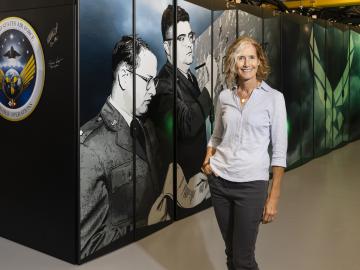
Filter News
Area of Research
News Type
News Topics
- (-) 3-D Printing/Advanced Manufacturing (22)
- (-) Big Data (11)
- (-) Grid (8)
- (-) High-Performance Computing (10)
- (-) Quantum Science (12)
- Advanced Reactors (8)
- Artificial Intelligence (23)
- Bioenergy (10)
- Biology (6)
- Biomedical (8)
- Biotechnology (3)
- Buildings (8)
- Chemical Sciences (14)
- Clean Water (8)
- Composites (8)
- Computer Science (44)
- Critical Materials (4)
- Cybersecurity (6)
- Emergency (1)
- Energy Storage (14)
- Environment (26)
- Exascale Computing (2)
- Fossil Energy (1)
- Frontier (3)
- Fusion (10)
- Isotopes (8)
- ITER (1)
- Machine Learning (10)
- Materials (7)
- Materials Science (26)
- Mathematics (2)
- Mercury (1)
- Microelectronics (1)
- Microscopy (5)
- Molten Salt (5)
- Nanotechnology (9)
- National Security (2)
- Neutron Science (25)
- Nuclear Energy (18)
- Partnerships (5)
- Physics (9)
- Polymers (5)
- Quantum Computing (3)
- Security (7)
- Simulation (6)
- Space Exploration (4)
- Statistics (1)
- Summit (9)
- Transportation (18)
Media Contacts
The contract will be awarded to develop the newest high-performance computing system at the Oak Ridge Leadership Computing Facility.

To better predict long-term flooding risk, scientists at the Department of Energy’s Oak Ridge National Laboratory developed a 3D modeling framework that captures the complex dynamics of water as it flows across the landscape. The framework seeks to provide valuable insights into which communities are most vulnerable as the climate changes, and was developed for a project that’s assessing climate risk and mitigation pathways for an urban area along the Southeast Texas coast.

Researchers at Oak Ridge National Laboratory have opened a new virtual library where visitors can check out waveforms instead of books. So far, more than 350 users worldwide have utilized the library, which provides vital understanding of an increasingly complex grid.

Researchers at Oak Ridge National Laboratory have developed free data sets to estimate how much energy any building in the contiguous U.S. will use in 2100. These data sets provide planners a way to anticipate future energy needs as the climate changes.

Oak Ridge National Laboratory scientists ingeniously created a sustainable, soft material by combining rubber with woody reinforcements and incorporating “smart” linkages between the components that unlock on demand.

Researchers at ORNL are developing battery technologies to fight climate change in two ways, by expanding the use of renewable energy and capturing airborne carbon dioxide.

Scientists at ORNL completed a study of how well vegetation survived extreme heat events in both urban and rural communities across the country in recent years. The analysis informs pathways for climate mitigation, including ways to reduce the effect of urban heat islands.

Groundwater withdrawals are expected to peak in about one-third of the world’s basins by 2050, potentially triggering significant trade and agriculture shifts, a new analysis finds.
The United States could triple its current bioeconomy by producing more than 1 billion tons per year of plant-based biomass for renewable fuels, while meeting projected demands for food, feed, fiber, conventional forest products and exports, according to the DOE’s latest Billion-Ton Report led by ORNL.

Kate Evans, director for the Computational Sciences and Engineering Division at ORNL, has been awarded the 2024 Society for Industrial and Applied Mathematicians Activity Group on Mathematics of Planet Earth Prize.


